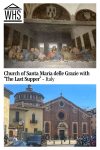Church and Dominican Convent of Santa Maria delle Grazie with “The Last Supper” by Leonardo da Vinci
By Chris Cavanaugh
What is the Church and Dominican Convent of Santa Maria delle Grazie with The Last Supper?
Santa Maria delle Grazie is a 15th-century church complex, originally commissioned by the Dukes of Sforza, one of the most powerful ruling families in Milan, Italy, during medieval times.
Duke Francesco Sforza initiated the building of the complex in 1463, but it wasn’t until 1492 that Duke Ludovico Sforza decided to embellish the convent. It’s thanks to Ludovico Sforza, who was a great patron of the arts, that we have The Last Supper, one of the most famous paintings in the world.
Ludovico invited Leonardo da Vinci to visit his court in Milan, where he took up residence between 1494 and 1498. While in Milan, he worked on different paintings, including some in the famous Sforzesco Castle. Ludovico commissioned The Last Supper for the Convent of Santa Maria delle Grazie because he felt it would help elevate his status as both a political and cultural leader.
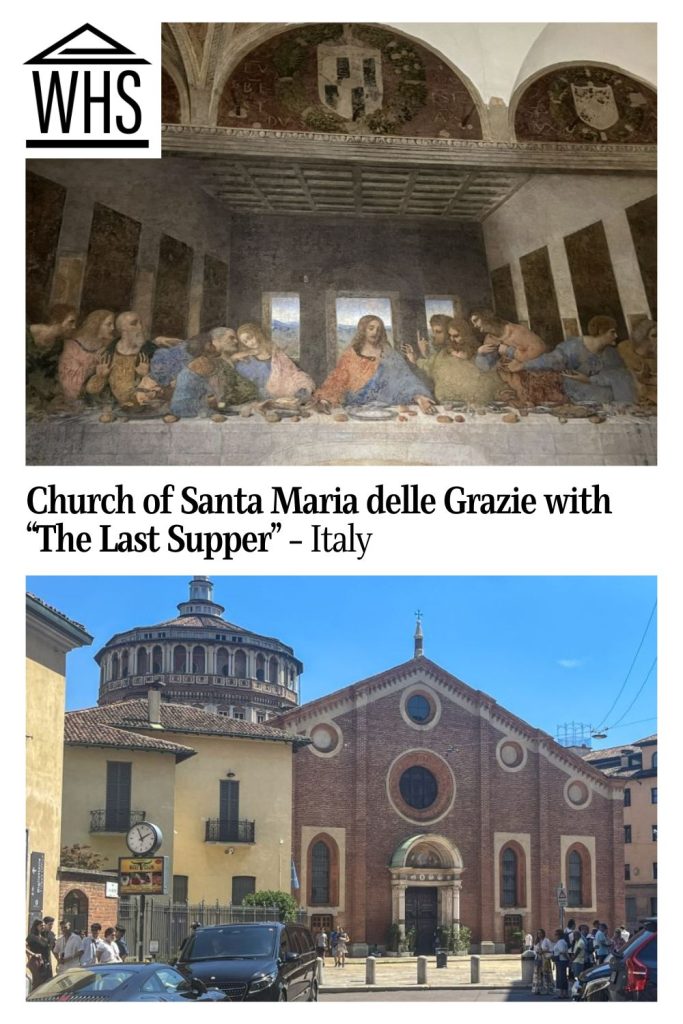
Disclosure: This article contains affiliate links. Making a purchase through an affiliate link will mean a small commission for this website. This will not affect your price. Privacy policy.
Thinking about all the historical impacts on the church, it feels like a small miracle that Leonardo da Vinci’s The Last Supper painting has survived. To name a few of the mishaps:
- In 1652, a monk cut a doorway through the painting, so Jesus no longer had legs and feet.
- During the 18th century, Napoleon took over the convent complex for military purposes, putting the painting in some danger.
- And during World War II, Milan and the complex were heavily bombed. The Last Supper had been protected with sandbags that helped support it. However, it was exposed to air for many months before new walls of the refectory could be rebuilt.
Why Is the Church and Convent of Santa Maria delle Grazie a UNESCO World Heritage site?
The church and convent of Santa Maria delle Grazie was named to the UNESCO World Heritage list in 1980 because of The Last Supper, not because of the building that houses it. According to UNESCO, it is a “timeless and unique artistic achievement.”
It has influenced countless artists, particularly in terms of the subject area of the Biblical Last Supper, portraying a single moment. UNESCO adds, “After five centuries, the Last Supper is one of most reproduced and copied paintings, and its creation in 1495-1497 is considered to have heralded a new phase in the history of art.”
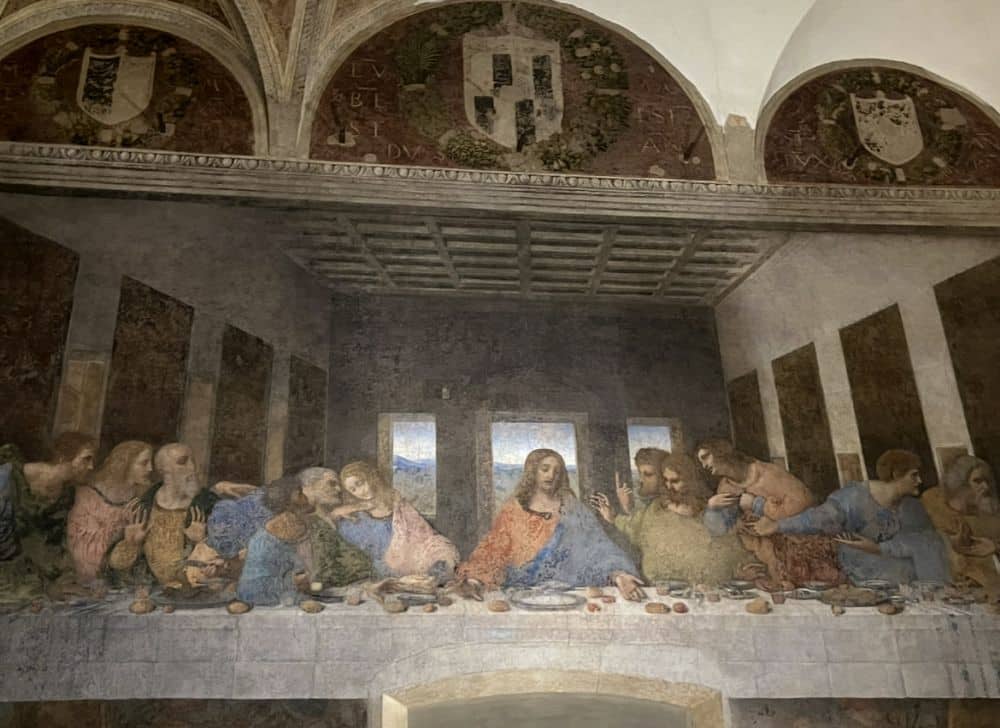
What can you expect on a visit to the Church of Santa Maria delle Grazie complex?
As you approach the complex, you might find yourself thinking that it looks like a church in any upscale neighborhood in Europe. It’s set around a piazza where you’ll see a mix of daily life, parents watching small children playing with balls, and people sipping coffee at tables outside a small café across the street. Then you might see a tour group of 30 foreigners walking down the street wearing audio guides and snapping photos of the elegant apartment buildings that line the streets leading to the piazza.
The start of your visit will kick off by entering a small building on the left side of the complex to pick up the tickets you pre-purchased online, assuming you are visiting independently of a tour group. You need to bring a formal ID(s) that aligns exactly with the name(s) that you used to purchase the tickets.
It’s important to be there at least 20 to 30 minutes prior to the time booked for your visit. The ticket system is quite regimented, as tickets are usually sold out months in advance. So don’t risk not getting there early.
Once you’ve collected your tickets from the ticket booth, you’ll head outside to the piazza. If you have some extra time, you can enter the main church. There, a few architectural highlights await, including a Renaissance apse designed by Donato Bramante in the 1490s. Walking toward the apse and altar, if you turn left, you’ll be able to enter the interior cloisters, known as the Frog Cloister, due to the frogs that fill the central fountain’s pool.
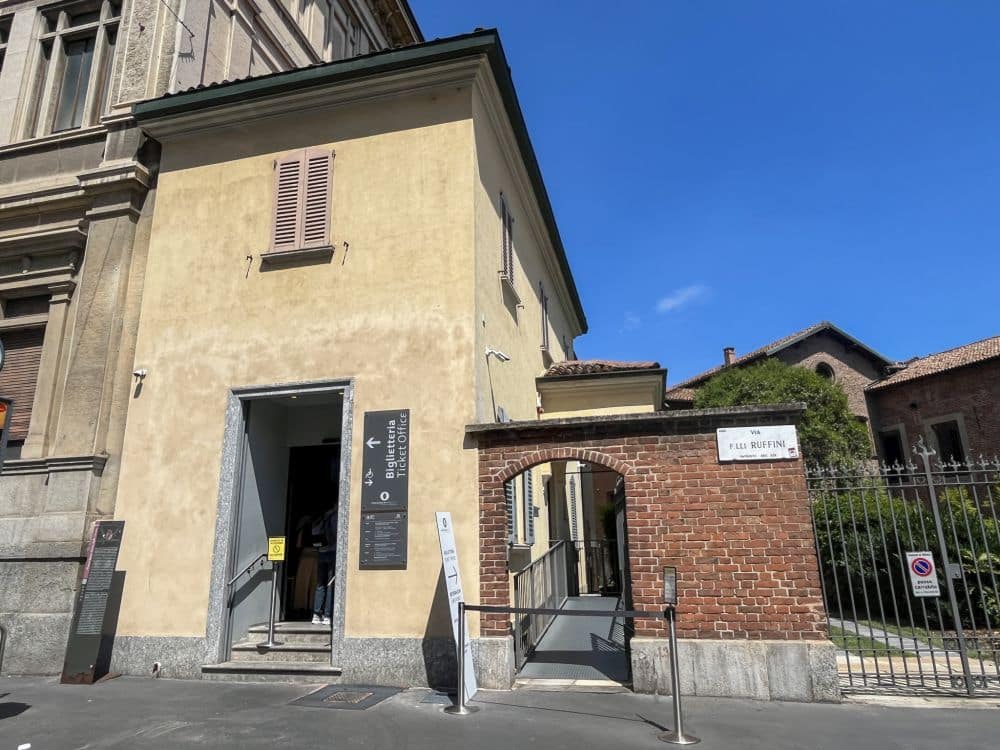
Just off this cloister is the Old Sacristy, also attributed to Bramante. It has a magnificent arched ceiling, while the side walls are lined with heavy wood paneling, accented by about 30 small paintings.
Make sure not to linger too long. You’ll want to be back outside, standing in front of the glass doors to the refectory entrance, about 10 minutes before the start of your timed ticket entrance. As you face the church, this separate entrance is just to the left of the church, with a banner calling out Cenacolo Vinciano (“Last Supper” in Italian). Groups of 15 to 35 go in at a time. You’ll enter and wait between two sets of doors that function as an airlock to regulate temperature, while minimizing moisture and dust.
Once you pass through the airlock, you enter the refectory: one large room with two paintings on the walls. On the back wall, the crucifixion by Donato Montorfano is a fresco from 1495 depicting the crucifixion of Christ. I found the most interesting thing in this painting is that the Sforza family is kneeling at the foot of the cross: both Ludovico and his wife Beatrice d’Este.
As you turn to the front of the building, you’ll see Leonardo’s magnificent The Last Supper covering the entire wall. He worked on it from 1494 to 1498, using tempera and oil paints to create this fresco.
In the painting, Jesus sits at a table with the 12 apostles. They all have vivid facial expressions, as it’s the exact moment after Christ announces that one of the apostles will betray him. It’s amazing to look at each of the individual faces and contemplate the different emotions they were feeling at the time.
Because The Last Supper is one of the most popular tourist attractions in Milan, the visit is very tightly timed. You get 15 minutes inside the refractory to admire the two paintings, and then you’re ushered out. If you want to spend more time at the complex, you can also book a 45-minute tour. This includes 15 minutes inside the refectory and a 30-minute visit to the rest of the complex. Booking of the tour needs to be done at the time of ticket purchase and adds to the cost.
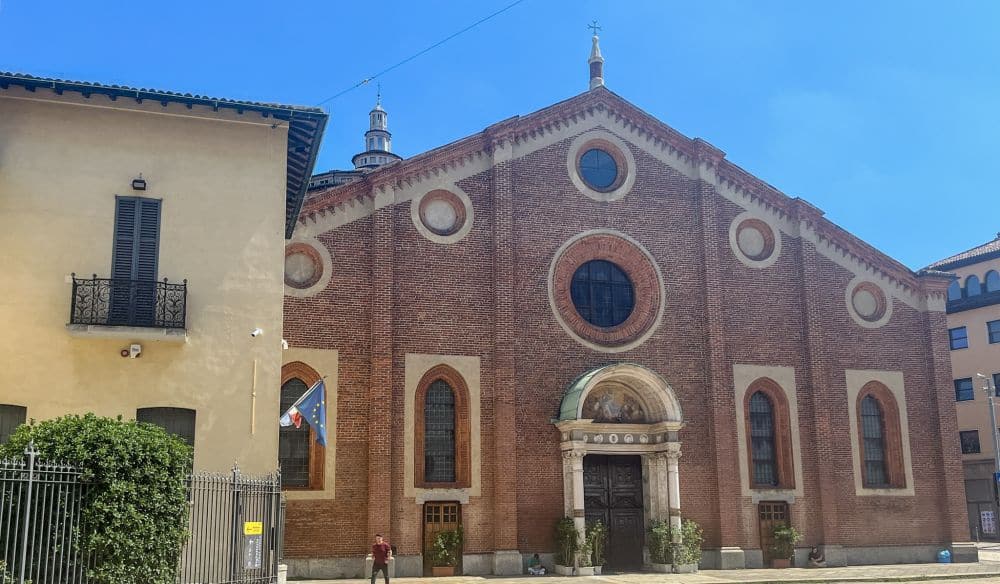
Is the Church of Santa Maria delle Grazie with The Last Supper worth visiting?
Yes, it’s worth visiting to see one of the most famous paintings in the world. The faces are so vivid and convey such emotion that you’ll quickly agree that Leonardo’s painting is a masterpiece.
However, I would only visit if you are able to buy your tickets for the refectory or the extended tour directly from the church. If these tickets are sold out, the other option is to book a tour via other websites. Here you’ll generally pay more. They often will add on a short tour of the Castle Sforzesco. I think this is too much money if all you want to see is that one fresco.
What sort of travelers would like the Church of Santa Maria delle Grazie?
I think almost anyone would enjoy seeing the Church and Convent of Santa Maria delle Grazie. It’s a compact experience, so you won’t find yourself wandering through what can sometimes feel like endless halls of mediocre art to find the couple of pieces you wanted to see. Instead, you’ll see two wall-sized paintings, one of which is one of the most famous in the world.

Tips for visiting the church and The Last Supper
As soon as you know the dates of your trip to Milan, start going online to try to buy your tickets directly from the Church of Santa Maria delle Grazie. Ticket sales open three months in advance for a three-month window. For example, on June 17th at noon, tickets were released for August, September and October dates.
When you buy your ticket, you’ll need to decide if you want to do a guided tour or not. Honestly, I would base it on what times are available. If you can buy only the refectory ticket, this is the most cost-effective. However, if there are only tickets left for the tour, the time is more convenient, or you’re a big fan of church interiors, then go for the ticket with the tour. There are generally six guided tours a day in English between Tuesday and Sunday.
If there is availability, I recommend buying a morning ticket for The Last Supper. You can start your day at one of the top breakfast spots in Milan, with a tasty brioche and cappuccino. Then head over to The Last Supper. This is a good strategy as you won’t need to continually check your phone to make sure you’re there on time. If you normally shop for clothes or souvenirs, going early means you won’t have to worry about where to store your purchases. Remember you can’t bring bags into the site.
Use the map below to book your accommodations in Milan. The map is centered around Santa Maria delle Grazie.
If you cannot find tickets online, I recommend checking the website daily. It’s updated for additional tickets that tour companies have cancelled. Additionally, each Wednesday at noon, they release any additional remaining tickets for the next week. If the above has failed, then the last option is to look to a tour site aggregator.
You’ll want to leave any backpacks, shopping bags, suitcases, etc. back at your hotel. There’s very limited storage at the convent, with about 10 lockers. So they’re really for emergencies only, as there’s not enough space for all visitors to store and lock baggage.
Other UNESCO sites not too far from Milan are Crespi D’Adda and the Sacri Monti (Sacred Mountains) of Piedmont and Lombardy.
Where is the Church of Santa Maria?
The church complex is in the center of Milan, Italy. The closest metro station is on the red line: Concialiazione/Ultima Cena station. From this stop, it’s just a 3-4-minute walk to the Piazza di Santa Maria delle Grazie.
Using public transportation is the best option as there is no public parking around the complex. It’s resident permit parking on the nearby streets. Parking garages in Milan are fairly expensive, and the closest ones are likely a 10-15 minute walk. If you are traveling around Italy by car, make sure your accommodation in Milan offers parking.
Compare rental car prices here.
For more details on opening hours and to pre-book your tickets online, please visit the church website directly.
Have you been to see The Last Supper? If so, do you have any additional information or advice about this UNESCO World Heritage site? Please add your comments below!

